Ijraset Journal For Research in Applied Science and Engineering Technology
- Home / Ijraset
- On This Page
- Abstract
- Introduction
- Conclusion
- References
- Copyright
Result and Analysis of Soft Computing Techniques for Diagnosis of Skin Diseases
Authors: Pooja A. Tambe, Dr. Mukta G. Dhopeshwarkar
DOI Link: https://doi.org/10.22214/ijraset.2024.63562
Certificate: View Certificate
Abstract
A prevalent bodily issue that has a significant impact on people\'s lives is skin disease. An early and precise identification of the condition can assist patients in receiving proper care, hastening their recovery. Convolutional neural networks (CNN) powered by deep learning have recently made major advancements that have greatly increased the accuracy of illness categorization. This led to the motivation for this work, which used deep CNN architectures to identify two different skin conditions—eczema and psoriasis. Ten fold cross validation has been utilized to examine the performance of five distinct cutting-edge CNN architectures. With the Adam optimizer, the Inception ResNet v2 architecture achieves a maximum validation accuracy of 97.1%. The results of the performance matrices suggest that the model performs remarkably well in terms of diagnosing skin disorders. Additionally, the study demonstrates two approaches for the practical application of the implemented model. (i) CNN Approach ii) PCA Approach.
Introduction
I. INTRODUCTION
One of the biggest and most noticeable organs in the body, the skin promotes survival and serves as a barrier against wounds, heat, and any damage that might be brought on by ultra violet rays. Unfortunately, numerous skin disorders impact about 900 million individuals worldwide. Skin illness is thus one of the most common diseases in today's globe. There are several skin conditions that might be painless or painful. Some skin problems are minor and others can be fatal, some have environmental origins, such as pollution, while others may be inherited. Correct skin disease diagnosis can be extremely important given the range of disease incidence characteristics. The therapies for skin illnesses seek to lessen the symptoms even if they are not always curative. It is challenging to thoroughly evaluate and analyze the skin illness because of the skin's irregularities, tone, hairiness, and other features. Even though skin cancer constitutes a single of the most prevalent malignancies in the world today, it is usually preventable. The severity of skin disorders can be reduced with early and precise diagnosis. Recent developments in deep learning based CNN models have significantly improved the classification process. Hence in this study, we aim to diagnose two common types of skin diseases using deep learning methods. Atopic dermatitis (eczema), a very common skin condition in children, is a condition that makes the skin red and itchy [1]. It is a chronic disease which may be accompanied by asthma or hay fever and tends to flare periodically. Psoriasis, another common skin disorder, which affects the outside of the elbows, knees or scalp, though it can appear on any location [2]. Recent advancements in CNN models powered by deep learning have substantially enhanced the categorization process. Therefore, the purpose of this work is to use deep learning techniques to identify two prevalent forms of skin illnesses. Eczema, also known as atopic dermatitis, is a skin ailment that affects a lot of kids and causes itchy, red skin [1]. It is a chronic condition that occasionally flares up and may be accompanied by asthma or hay fever. Another frequent skin condition is psoriasis, which often affects the scalp, outsides of the knees, and elbows [2]. Psoriasis has been described by some as being itchy, stinging, and burning. It can occasionally coexist with other medical disorders such diabetes, heart disease, and depression. In order to classify the four frequent disorders in this essay—acne, psoriasis, and eczema—we first identified their distinguishing characteristics.
II. RELATED WORK
Humans are seeing a sharp increase in the prevalence of skin diseases. Over the years, several machine learning and deep learning algorithms and models for diagnosing skin disorders have been developed by various researchers. A technique for diagnosing psoriasis was presented by Abbadi et al. [3] based on skin texture and color data obtained from the Grey Level Co-occurrence Matrix (GLCM). In order to distinguish between input photos of infected and non-infected psoriasis, feed-forward neural networks have been employed.
A sensor-based intelligent skin disease detection system that can recognize skin disorders by only analyzing camera video was proposed by Poap et al. in their study [4]. With an acceptable training accuracy of 82.4%, their suggested CNN architecture displays a promising outcome. An automated eczema identification and severity measuring methodology is suggested in [5], taking into account how expensive and time-consuming the procedure of diagnosing skin diseases is. The suggested technique may identify eczema-affected regions based on the color and texture features of a picture. The discovered areas are classified as mild or severe using the Support Vector Machine (SVM) classifier. Similar techniques have been utilized at [6] to diagnose chronic renal illness using a variety of machine learning classifiers. On a smaller dataset of chronic kidney disease cases, Naive Bayes had the greatest classification accuracy in the trial, 99.1%. The experiment used a smaller dataset with a range of attribute counts. The dataset characteristics were deleted after taking into account a number of criteria, which ultimately improved the classification accuracy. Abdulbaki et al. have suggested an architecture based on cloud computing [7]. Back-propagation Neural Network (BpNN) and cloud computing have been integrated in this study to detect eczema. For diagnosing different types of skin cancer, Janoria et al. [8] developed a transfer learning-based CNN architecture. When using machine learning classifiers to diagnose illnesses, they employed CNN to extract features from the photos. The results of the experimental research demonstrate that the K-Nearest Neighbor algorithm and the VGG-16 CNN model combined for the maximum accuracy of 99%. The performance of several machine learning techniques using Convolutional Neural Networks (CNN) was examined in the study of Bhadula et al. [9]. With a training and testing accuracy of 99.1% and 96%, respectively, the CNN model surpassed all other machine learning techniques. A CNN architecture was suggested for the automated identification of skin disorders in the work of Shanthi et al. [10]. The eleven layers of the suggested model include multiple convolution, pooling, an activation layer, and a softmax classifier. According to the experimental research, the suggested model has an accuracy of about 99%. For the diagnosis of renal illness [11], heart disease [12], rice plant disease [13], and Alzheimer's disease [14], similar types of CNN models have been proposed.
III. PROPOSED SYSTEM
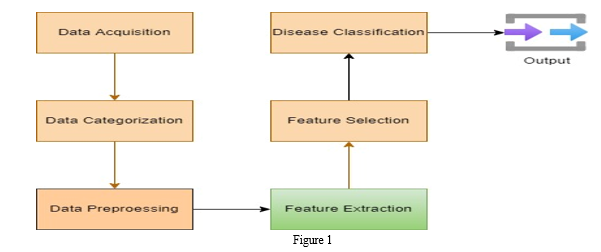
The deep learning-based skin disease prediction model's working method involves collecting data initially, then categorizing the dataset. Utilizing CNN architectures, various data pre-processing and cleaning procedures are carried out, and features are retrieved. Finally, the dense layer of CNN is used to do the classification. Despite being one of the largest and most apparent organs that contribute to survival, around 900 million individuals worldwide suffer from various skin ailments. Skin problems can range from the minor to the potentially fatal. Atopic dermatitis (Eczema) and psoriasis are two frequent forms of skin conditions that we have taken into consideration in our work.
IV. PREPROCESSING
A collection of 1000 disease-affected skin photos, including 490 Eczema images and 510 Psoriasis images, was created after manually identifying and eliminating certain noisy, low contrast images from the dataset.
We gathered examples of skin illness photographs from various body areas, so we have a complete set of images for every type of condition. Figure 2.0 displays sample dataset pictures. Pre-processing a picture is a crucial part of detection since it improves the original image's quality by removing noise. It was necessary to use it in order to restrict the search for anomalies in the background factors influencing the outcome [8]. The main goal of this stage is to improve the image's quality by eliminating surplus and unrelated background elements before further processing.
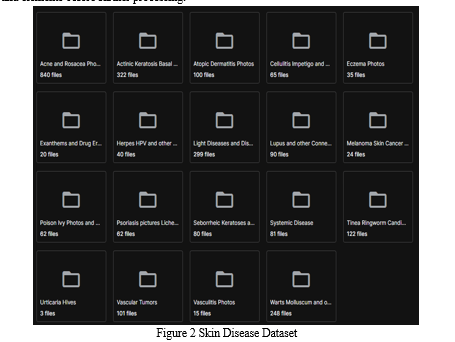
Pixel brightness transformations/ Brightness corrections
The brightness of a pixel is altered through brightness transformations, which are dependent on the characteristics of the individual pixel. In PBT, the value of the output pixel depends only on the value of the matching input pixel. Adjustments to brightness and contrast, as well as color transformations and correction, are a few examples of such operators. Enhancing contrast is a crucial component of image processing for both human and machine vision.
g(x) =αf(x)+β
The gain and bias parameters, which are also known as α>0 and β, are referred to as controlling contrast and brightness, respectively, at times. When using the function cv.convertScaleAbs(image, alpha=alpha, beta=beta), the brightness and contrast of the picture change according on the alpha and beta values.
V. FEATURE EXTRACTION
The process of recovering the deteriorated image from a blurry and noisy one is known as image restoration [25].Different methods can be used to recover the damaged photos. Defects in the imaging system, poor focusing, motion, and other factors can all contribute to picture deterioration, which often results in noisy or blurry images [25]. Often based on the properties of the picture's pixels, image segmentation is a widely used method in digital image processing and analysis to divide an image into various portions or areas. Foreground and background may be distinguished in an image via segmentation, and pixels can be grouped together according to their similarity in colour or form. Pixels are grouped via non-contextual thresholding without taking into account their varying positions within the picture plane. Because contextual segmentation takes into consideration how near together specific object-related pixels are, it can be more effective at distinguishing distinct items. Based on signal discontinuity or similarity, there are two fundamental methods for contextual segmentation. Red, green, and blue spectral wavelengths are represented in the colour space known as RGB. RGB is the colour format that is used in image processing the most commonly. Other colour space representations have been created since RGB has some limitations in high level processing.
VI. FEATURE SELECTION
Choosing important characteristics from the RGB block is part of the feature selection step. A global adaptive binarization threshold image segmentation technique, the OTSU method (OTSU) was proposed by Japanese researchers OTSU in 1979. The threshold selection rule for this approach uses the highest interclass variance between the background and the target picture. The greatest between-class variance approach is also known as the OTSU method and is based on its underlying theory. According to the properties of the grey scale, it separates the picture into the foreground and background. The difference between the two portions is greatest when the optimal threshold is used. The measure standard for the OTSU method is the highest interclass variance, which is a very frequent variance. Variance is a crucial indicator of uniform grey distribution, therefore the larger the variance number, the more disparate the two halves of the graph are from one another. The disparity between the two portions will decrease if some targets are improperly sorted into backgrounds or if some backgrounds are incorrectly divided into targets. Therefore, the likelihood of misclassification will be reduced as long as the variation between clusters is maximised, realising the ideal segmentation of an image.
CNN
Convolutional Neural Networks are supervised machine learning algorithms that may be trained using labelled data from the appropriate classes and are used to describe picture identification and classification. Compared to the inception model, which offers superior accuracy when categorizing numerous classes, our implementation is an improvement. As a result, we tested these designs using our dataset to see how they performed using various criteria. With the last dense layer of the CNN architectures unfrozen and all other layer weights frozen, we utilized a fine-tuning approach to train the structures with the softmax classification layer. We then initialized random weights to the nodes and trained the dense layer using our dataset for skin diseases. Utilizing optimizers, the networks changed the weights as necessary.
VII. CLASSIFICATION
Our trained system can then utilize this dataset to categories the supplied picture with the most comparable weights acquired as compared to the test image provided by the user. This classification is based on total vector weights and features with test images, and we use a CSV file to record all relevant class labels. Deep learning for skin disease prediction. The primary goal of this study is to forecast skin diseases as accurately as possible. Early skin disease diagnosis is made possible by deep learning algorithms. The categorization of skin disorders relies heavily on feature extraction.Utilising Deep Learning algorithms lessens the requirement for manual data reconstruction and feature extraction for classification purposes.
Following are the list of skin diseases:
- Acne
- Eczema
- Melanoma
- Psoriasis
TABLE 1 SKIN DISEASE DATASET VALIDATION
|
Disease type |
Training data |
Validation data |
|
Eczema |
2352 |
588 |
|
Psoriasis |
2448 |
612 |
|
Melanoma |
1352 |
488 |
|
Acne |
2331 |
566 |
Data augmentation, which enables professionals to dramatically expand the diversity of data available for training models without gathering new data, is crucial in reducing the over-fitting issue. On our dataset, data augmentation methods like brightness augmentation by 20%, contrast augmentation by 10%, random rotation by 5 C, and horizontal flipping have been employed for improved interaction and taking into account all potential variations. We produced five distinct enhanced versions of each example image in this way. To split the training and validation data, we employed an 80-20 ratio. Consequently, there are 4800 training photos and 1200 validation images. To split the training and validation data, we employed an 80-20 ratio. Consequently, there are 4800 training photos and 1200 validation images. We used 400 pictures of skin conditions that we found online for testing purposes. The training pictures' traits are present in these testing photos as well. To minimize any predisposition, the testing photos were completely separated from the training and validation data.
Optimized Implementation
In order to increase accuracy, we utilized to modify the weights and learning rates of CNN architectures. In our research. Adam (Adaptive Moment Estimation) employs first- and second-order momentum [22]. For each parameter, Adam calculates adaptive learning rates. In addition to storing average past gradients that exponentially decay, OCNN also saves average past gradients that exponentially decay.
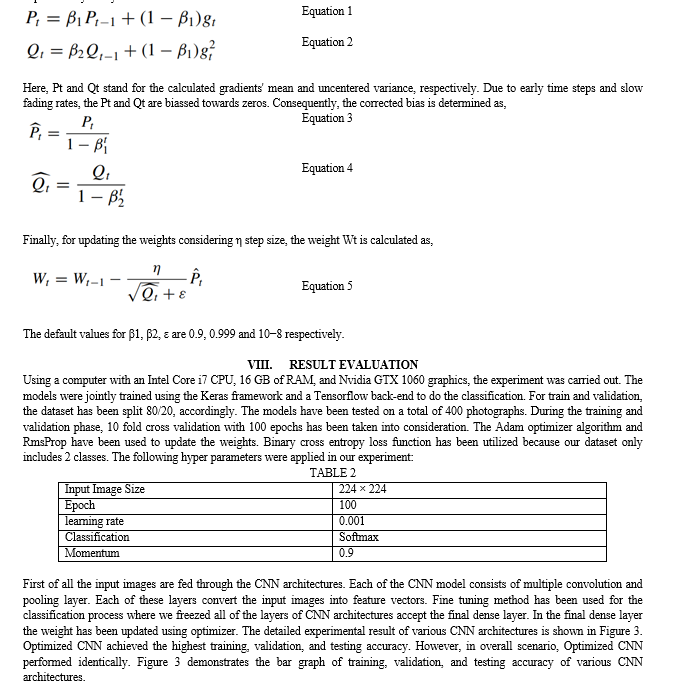
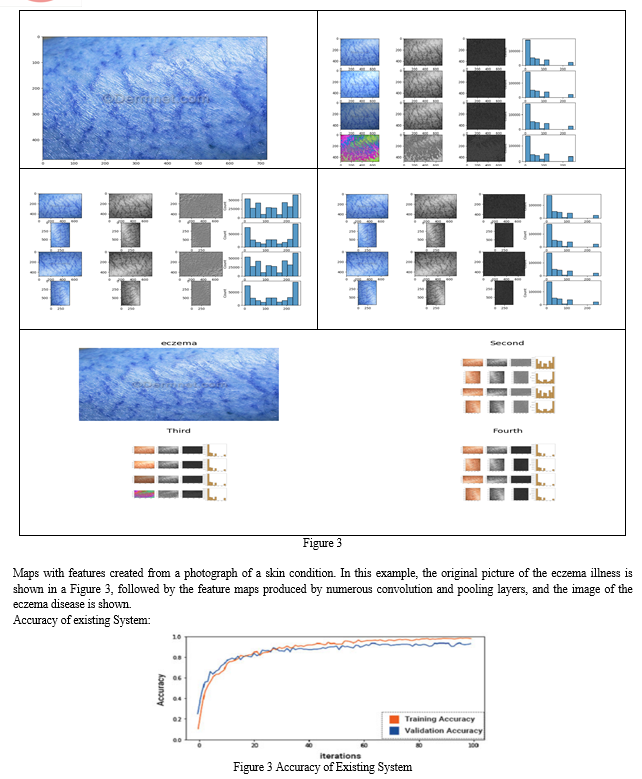

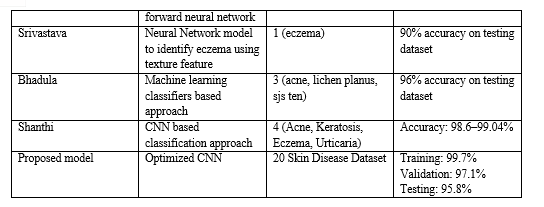
IX. ACKNOWLEDGMENT
The authors would like to acknowledge and thank to SARTHI, Pune they awarded fellowship, Department of CS & IT, Dr. Babasaheb Ambedkar Marathwada University, Chh.Sambhajinagar, Maharashtra, India.
Conclusion
Medical science will advance on a larger scale with the use of computational support and disease detection. In this research, we developed deep learning-based approaches for detecting 21 common skin illnesses, such as eczema and psoriasis, utilizing several CNN architectures. Five distinct CNN architectures were trained using a fine-tuning technique utilizing optimized CNN. With a validation and testing accuracy of 97.1% and 95.8%, respectively, our model surpassed all existing CNN designs. Two methods have finally been used to illustrate a functional application. This application will eventually be developed for smart phones and the web.
References
[1] Ruzicka, T., Ring, J., Przybilla, B.: Handbook of atopic eczema, 2nd edn. Springer Science & Business Media (2013). [2] Lowes, M.A., Suarez-Farinas, M., Krueger, J.G.: Immunology of psoriasis. Ann. Rev. Immunol. 32, 227–255 (2014). [3] Al Abbadi, N.K., Dahir, N.S., AL-Dhalimi, M.A., Restom, H.: Psoriasis detection using skin color and texture features. J. Comput. Sci. 6(6), 648–652 (2010). [4] Po?ap, D., Winnicka, A., Serwata, K., K¸esik, K., Wo´zniak, M.: An intelligent system for monitoring skin diseases. Sensors 18, 2552 (2018). [5] Alam, M.N., Munia, T.T.K., Tavakolian, K., Vasefi, F., MacKinnon, N., Fazel-Rezai, R.: Automatic detection and severity measurement of eczema using image processing. In: 2016 38th Annual International Conference of the IEEE Engineering in Medicine and Biology Society, pp. 1365–1368. IEEE (2016). [6] Khan, M.T.I., Prottasha, M.S.I., Nasim, T.A., Mehedi, A.A., Pranto, M.A.M., Asad, N.A.: Performance analysis of various machine learning classifiers on reduced chronic kidney disease dataset. Int. J. Rec. Res. Rev. (IJRRR), XIII(4), 16–21 (2020). [7] Shawkat Abdulbaki, A., Najim, S.A.M., Abdulrasoul Khadim, S.: Eczema disease detection and recognition in cloud computing. Res. J. Applied Sci. 13, 182–188 (2019). [8] Janoria, H., Minj, J., Patre, P.: Classification of skin disease from skin images using transfer learning technique. In: 2020 4th International Conference on Electronics, Communication and Aerospace Technology (ICECA), pp. 888–895. IEEE (2020). [9] Bhadula, S., Sharma, S., Juyal, P., Kulshrestha, C.: Machine learning algorithms based skin disease detection. IJITEE 9(2), 4044–4049 (2019). [10] Shanthi, T., Sabeenian, R.S., Anand, R.: Automatic diagnosis of skin diseases using convolution neural network. Microprocess. Microsyst. 76, 103074 (2020). [11] Bhaskar, N., Manikandan, S.: A deep-learning-based system for automated sensing of chronic kidney disease. IEEE Sens. Lett. 3, 1–4 (2019). [12] Shankar, V., Kumar, V., Devagade, U., Karanth, V., Rohitaksha, K.: Heart disease prediction using CNN algorithm. SN Comput. Sci. 1, 170 (2020). [13] Prottasha, M.S.I., Hossain, A.B.M., Rahman, M.Z., Reza, S.M.S., Hossain, D.A.: Identification of various rice plant diseases using optimized convolutional neural network. Int. J. Comput. Dig. Syst. (IJCDS) 9 (2021). [14] Farooq, A., Anwar, S., Awais, M., Rehman, S.: A deep CNN based multi-class classification of Alzheimer’s disease using MRI. In: 2017 IEEE International Conference on Imaging Systems and Techniques (IST), pp. 1–6. IEEE, Beijing, China (2017). [15] Dermnet: Dermatology Pictures—Skin Disease Pictures. http://www.dermnet.com/images/ Eczema-Photos. Last accessed 30 Aug. 2019. [16] Psoriasis Department of Dermatology. https://medicine.uiowa.edu/dermatology/psoriasis. Last accessed 27 Aug. 2019. [17] Simonyan, K., Zisserman, A.: Very deep convolutional networks for large-scale image recognition. CoRR. abs/1409.1556 (2015). [18] Szegedy, C., Vanhoucke, V., Ioffe, S., Shlens, J., Wojna, Z.: Rethinking the inception architecture for computer vision. In: 2016 IEEE Conference on Computer Vision and Pattern Recognition (CVPR), pp. 2818–2826. IEEE, Las Vegas, USA (2016). [19] He, K., Zhang, X., Ren, S., Sun, J.: Deep residual learning for image recognition. In: 2016 IEEE Conference on Computer Vision and Pattern Recognition (CVPR), pp. 770–778. IEEE, Las Vegas, USA (2016). [20] Sandler, M., Howard, A., Zhu, M., Zhmoginov, A., Chen, L.: MobileNetV2: inverted residuals and linear bottlenecks. In: 2018 IEEE/CVF Conference on Computer Vision and Pattern Recognition, pp. 4510–4520. IEEE, Salt Lake City, UT (2018). [21] Szegedy, C., Ioffe, S., Vanhoucke, V., Alemi, A.: Inception-v4, inception-ResNet and the impact of residual connections on learning. In: AAAI Conference on Artificial Intelligence, pp. 4278– 4284 (2016). [22] Kingma, D., Ba, J.: Adam: a method for stochastic optimization. In: 3rd International Conference for Learning Representations, IEEE, pp. 1–13, San Diego (2015). [23] Hinton, G.: Lecture 6.5—RMSProp. COURSERA: neural networks for machine learning. Technical report, COURSERA (2012).
Copyright
Copyright © 2024 Pooja A. Tambe, Dr. Mukta G. Dhopeshwarkar. This is an open access article distributed under the Creative Commons Attribution License, which permits unrestricted use, distribution, and reproduction in any medium, provided the original work is properly cited.

Download Paper
Paper Id : IJRASET63562
Publish Date : 2024-07-05
ISSN : 2321-9653
Publisher Name : IJRASET
DOI Link : Click Here
 Submit Paper Online
Submit Paper Online

